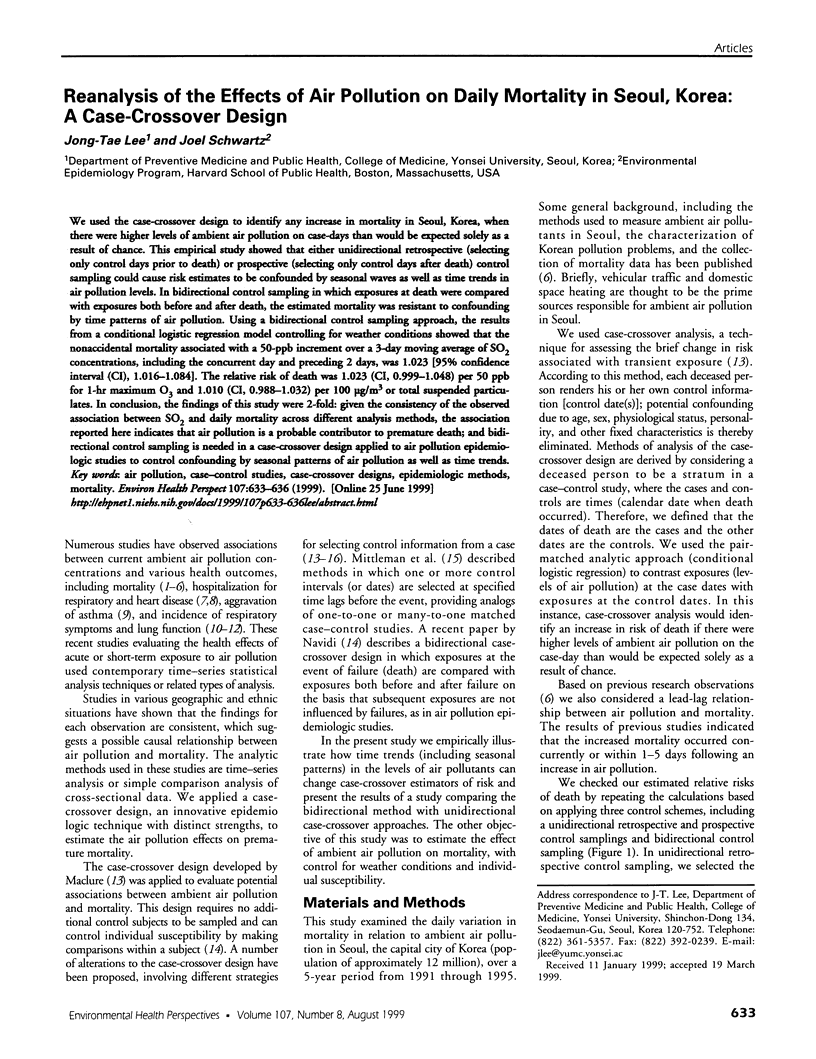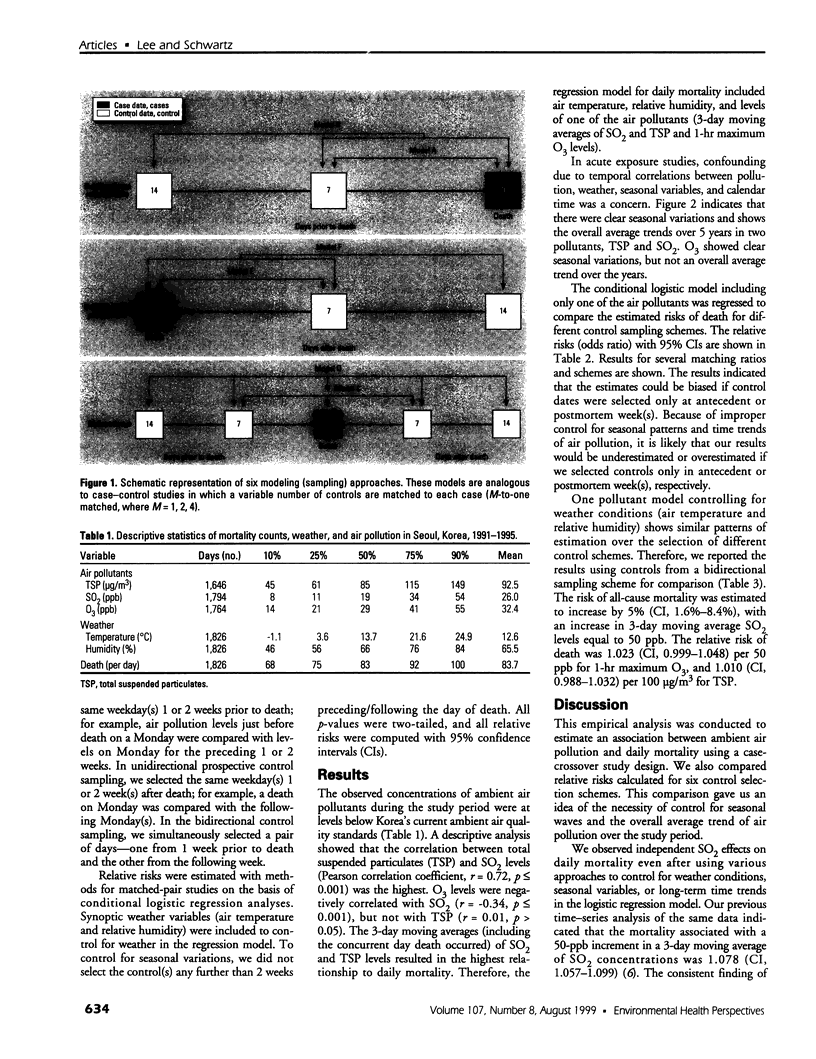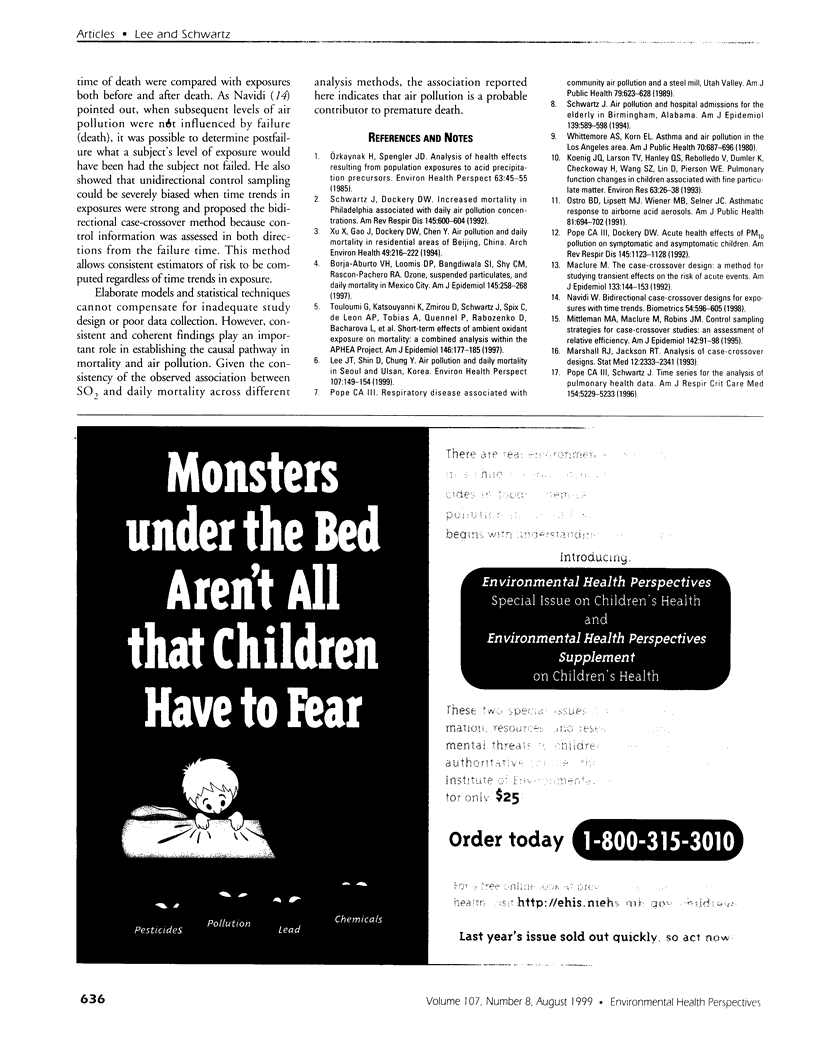Abstract
We used the case-crossover design to identify any increase in mortality in Seoul, Korea, when there were higher levels of ambient air pollution on case-days than would be expected solely as a result of chance. This empirical study showed that either unidirectional retrospective (selecting only control days prior to death) or prospective (selecting only control days after death) control sampling could cause risk estimates to be confounded by seasonal waves as well as time trends in air pollution levels. In bidirectional control sampling in which exposures at death were compared with exposures both before and after death, the estimated mortality was resistant to confounding by time patterns of air pollution. Using a bidirectional control sampling approach, the results from a conditional logistic regression model controlling for weather conditions showed that the nonaccidental mortality associated with a 50-ppb increment over a 3-day moving average of SO(2) concentrations, including the concurrent day and preceding 2 days, was 1.023 [95% confidence interval (CI), 1.016-1.084]. The relative risk of death was 1.023 (CI, 0.999-1.048) per 50 ppb for 1-hr maximum O(3) and 1.010 (CI, 0.988-1.032) per 100 microg/m(3 )or total suspended particulates. In conclusion, the findings of this study were 2-fold: given the consistency of the observed association between SO(2) and daily mortality across different analysis methods, the association reported here indicates that air pollution is a probable contributor to premature death; and bidirectional control sampling is needed in a case-crossover design applied to air pollution epidemiologic studies to control confounding by seasonal patterns of air pollution as well as time trends.
Full text
PDF



Images in this article
Selected References
These references are in PubMed. This may not be the complete list of references from this article.
- Borja-Aburto V. H., Loomis D. P., Bangdiwala S. I., Shy C. M., Rascon-Pacheco R. A. Ozone, suspended particulates, and daily mortality in Mexico City. Am J Epidemiol. 1997 Feb 1;145(3):258–268. doi: 10.1093/oxfordjournals.aje.a009099. [DOI] [PubMed] [Google Scholar]
- Koenig J. Q., Larson T. V., Hanley Q. S., Rebolledo V., Dumler K., Checkoway H., Wang S. Z., Lin D., Pierson W. E. Pulmonary function changes in children associated with fine particulate matter. Environ Res. 1993 Oct;63(1):26–38. doi: 10.1006/enrs.1993.1123. [DOI] [PubMed] [Google Scholar]
- Lee J. T., Shin D., Chung Y. Air pollution and daily mortality in Seoul and Ulsan, Korea. Environ Health Perspect. 1999 Feb;107(2):149–154. doi: 10.1289/ehp.99107149. [DOI] [PMC free article] [PubMed] [Google Scholar]
- Maclure M. The case-crossover design: a method for studying transient effects on the risk of acute events. Am J Epidemiol. 1991 Jan 15;133(2):144–153. doi: 10.1093/oxfordjournals.aje.a115853. [DOI] [PubMed] [Google Scholar]
- Marshall R. J., Jackson R. T. Analysis of case-crossover designs. Stat Med. 1993 Dec 30;12(24):2333–2341. doi: 10.1002/sim.4780122409. [DOI] [PubMed] [Google Scholar]
- Mittleman M. A., Maclure M., Robins J. M. Control sampling strategies for case-crossover studies: an assessment of relative efficiency. Am J Epidemiol. 1995 Jul 1;142(1):91–98. doi: 10.1093/oxfordjournals.aje.a117550. [DOI] [PubMed] [Google Scholar]
- Navidi W. Bidirectional case-crossover designs for exposures with time trends. Biometrics. 1998 Jun;54(2):596–605. [PubMed] [Google Scholar]
- Ostro B. D., Lipsett M. J., Wiener M. B., Selner J. C. Asthmatic responses to airborne acid aerosols. Am J Public Health. 1991 Jun;81(6):694–702. doi: 10.2105/ajph.81.6.694. [DOI] [PMC free article] [PubMed] [Google Scholar]
- Ozkaynak H., Spengler J. D. Analysis of health effects resulting from population exposures to acid precipitation precursors. Environ Health Perspect. 1985 Nov;63:45–55. doi: 10.1289/ehp.856345. [DOI] [PMC free article] [PubMed] [Google Scholar]
- Pope C. A., 3rd, Dockery D. W. Acute health effects of PM10 pollution on symptomatic and asymptomatic children. Am Rev Respir Dis. 1992 May;145(5):1123–1128. doi: 10.1164/ajrccm/145.5.1123. [DOI] [PubMed] [Google Scholar]
- Pope C. A., 3rd Respiratory disease associated with community air pollution and a steel mill, Utah Valley. Am J Public Health. 1989 May;79(5):623–628. doi: 10.2105/ajph.79.5.623. [DOI] [PMC free article] [PubMed] [Google Scholar]
- Schwartz J. Air pollution and hospital admissions for the elderly in Birmingham, Alabama. Am J Epidemiol. 1994 Mar 15;139(6):589–598. doi: 10.1093/oxfordjournals.aje.a117048. [DOI] [PubMed] [Google Scholar]
- Schwartz J., Dockery D. W. Increased mortality in Philadelphia associated with daily air pollution concentrations. Am Rev Respir Dis. 1992 Mar;145(3):600–604. doi: 10.1164/ajrccm/145.3.600. [DOI] [PubMed] [Google Scholar]
- Touloumi G., Katsouyanni K., Zmirou D., Schwartz J., Spix C., de Leon A. P., Tobias A., Quennel P., Rabczenko D., Bacharova L. Short-term effects of ambient oxidant exposure on mortality: a combined analysis within the APHEA project. Air Pollution and Health: a European Approach. Am J Epidemiol. 1997 Jul 15;146(2):177–185. doi: 10.1093/oxfordjournals.aje.a009249. [DOI] [PubMed] [Google Scholar]
- Whittemore A. S., Korn E. L. Asthma and air pollution in the Los Angeles area. Am J Public Health. 1980 Jul;70(7):687–696. doi: 10.2105/ajph.70.7.687. [DOI] [PMC free article] [PubMed] [Google Scholar]
- Xu X., Gao J., Dockery D. W., Chen Y. Air pollution and daily mortality in residential areas of Beijing, China. Arch Environ Health. 1994 Jul-Aug;49(4):216–222. doi: 10.1080/00039896.1994.9937470. [DOI] [PubMed] [Google Scholar]





